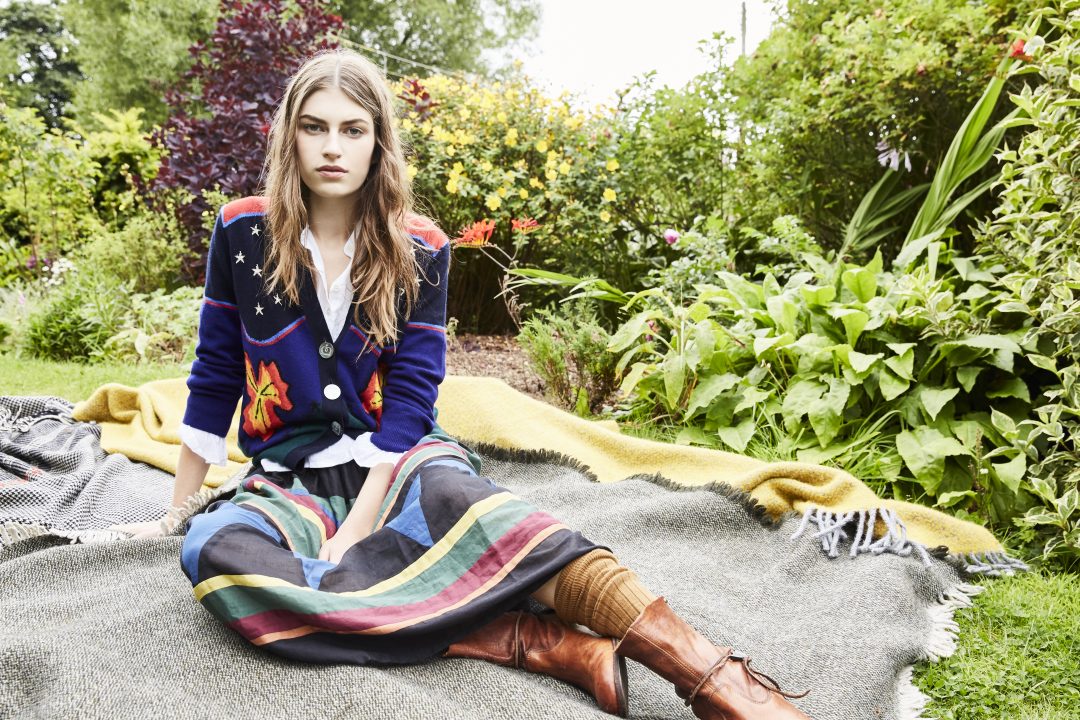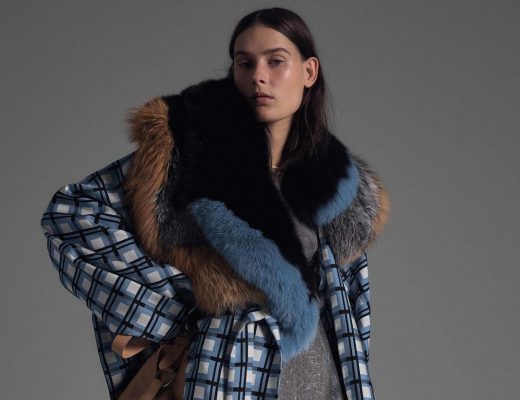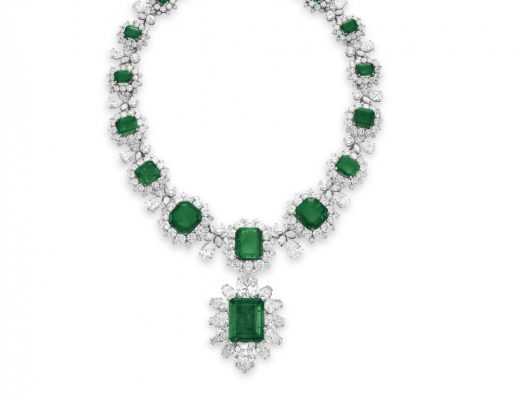Angela Bell, the Scottish Cashmere Queen behind cultish sweater label Queene and Belle talks to the Extravagant about all things cashmere, her F/W2018 collection and collecting Edwardian vintage.
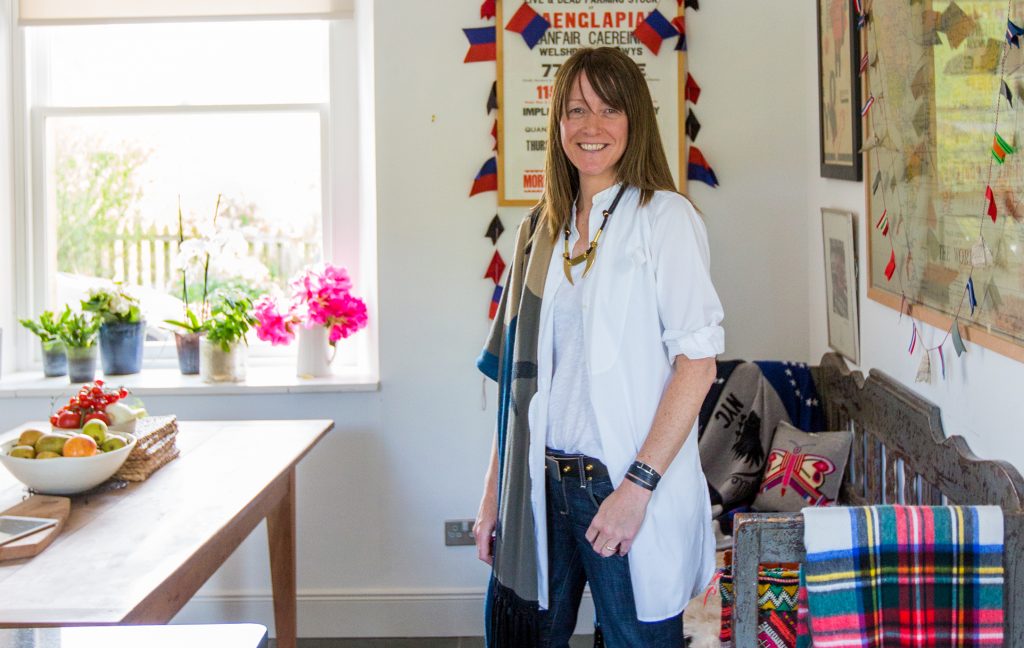
Angela Bell at her Scottish Borders Studio
Queene and Belle was founded in 2000 on the premise that snooze-inducing Argyles and Twin-sets needed a major rebrand. It is hard to find a more knowledgeable and passionate creative. Taking full advantage of generations of family knowledge, Scottish production resources, and time spent at Pringle, Bell creates her pieces in the scenic Scottish Borders, which she calls home. The vivacious designs are painstakingly executed through hand-knitting and intarsia techniques that take hours to realize, using decadent 6-ply yarns from Todd & Duncan. Each jumper is lovingly finished with a hand-stitched stylized St. Edward’s Crown.
Bell cites both her grandmothers as the Original Fashionistas in her life, although she draws a lot from contemporary iconography, she is always ready with a timely and on trend collection like this season’s Wild West themed confection. The label has recently added non-cashmere offerings to compliment its main design area because, let’s face it, nothing goes better with a boyfriend sweater than a poplin sundress. The perpetually cold amongst us rejoice.
What drew you to jumpers? Do you have a favourite one?
“My family have all been involved in the local cashmere industry for 4 generations, so I was always surrounded by sweaters. My dad must have had around 20 navy classics so I used to ‘borrow’ them! I guess, I’m always drawn to an oversize navy cashmere sweater because of this!”
Walk us through your design process at Queene and Belle. What is your favourite part? From where do you draw inspiration?
“I continually collect images, visit art exhibitions and people watch for inspiration and I especially love the textiles and patterns from Native American Indians. When I start designing I review all of what I have collected and, through a certain gut feeling, start to assemble my ideas for the new collection.”
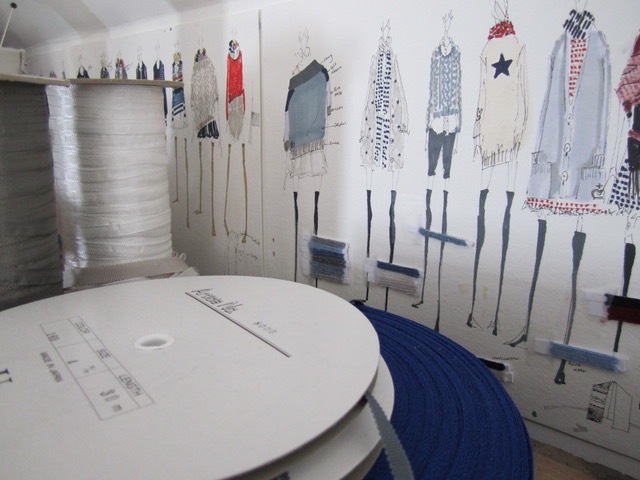
Croquis Galore, Queene and Belle A/W2018
“When my designs are formulated, I draw up each design specification and issue them to the factory. I discuss the various knit samples I require and after they have produced these, the factory will go ahead with the actual samples. If new body shapes are needed or if new developments for knit trims are required, this is all done at this stage. It usually takes around 5-7 weeks for the factory to produce the sample collection and I continually visit the various technicians to discuss the work in progress. When the collection is finished, we arrange the photo shoot which is always done on the farm where I live. I use my home as well as the farm buildings (which date from the 1700’s) as an interior and the surrounding hills for the outside shots. Everything is done locally and my customers love that the ethos behind Queene and Belle is very much a personal story. I personally style the collection during the photoshoot, it’s my favourite part of the process as I love putting together new looks and seeing my vision come to life.”
What makes a Queene and Belle Jumper distinct from other luxury knitwear labels?
“Queene and Belle sweaters always have lots of detailing whether it be our hand stitched crown, signature etched buttons, detailed intarsia or quirky take on a classic. All of our sweaters are very easy to wear and feel so light and soft. We also do very small runs and bespoke colours so customers will always have something very unique in this world of mass production (even at the top end of the market).”
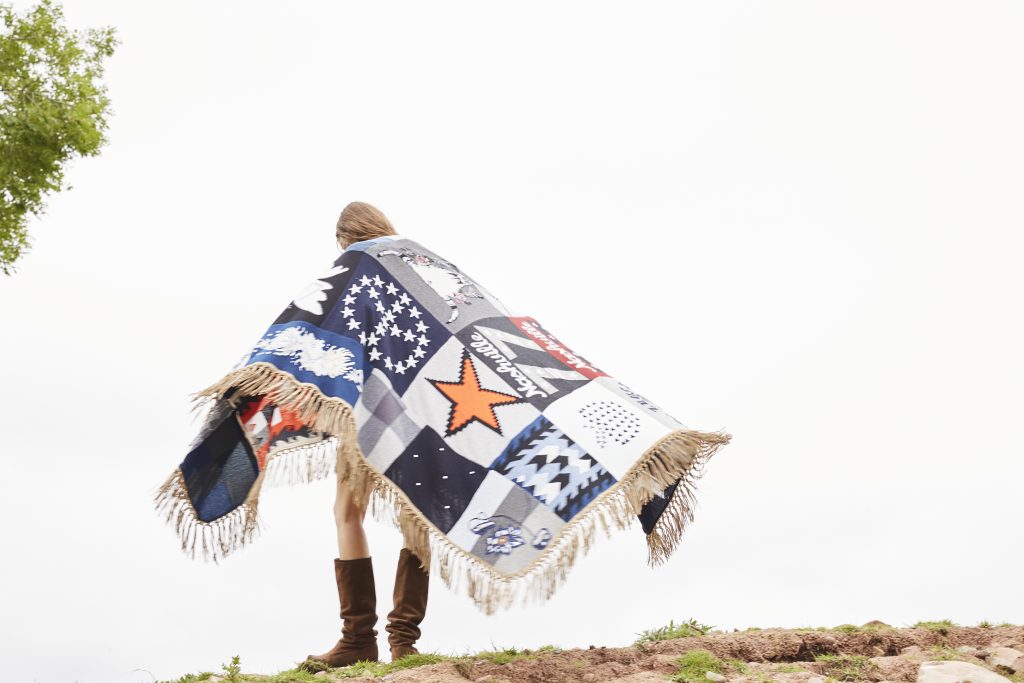
Farm Camp Heritage Blanket, Queene and Belle A/W 2018.
Who makes a Queene and Belle Jumper? What is the brand’s value chain from fiber to end product? What about for the brand’s non-knitwear components?
“All of our knitwear is made in the local town of Hawick, which is famous for producing the finest cashmere for over 200 years. The yarn comes from Todd and Duncan who are based north of Edinburgh in Fife, a company who spin wonderful cashmere, yarn that is spun tighter than in other countries and therefore is less likely to pill and makes the final product last much longer. Having our knitwear produced locally means we can check everything at every stage and also do a lot of hand finishing in our studio.
Our cotton summer dresses and tops are all made by a family business in India who only make clothing for us. They are extremely talented and are able to construct the most intricate lace paneling, embroideries and shapes as most of our designs are inspired by vintage Victorian and Edwardian pieces. They only make what we sell, which is very important to us as we don’t want to overproduce. The same goes for our knitwear each piece is made to order.”
How does Scotland inform the brand? What are the challenges of working in Scotland?
“I think Scotland is very quiet and reserved…. a place to be discovered but truly loved when you take the time to visit. I see Queene and Belle in the same way. I love working in Scotland especially as my studio is on the family farm, it’s quiet and peaceful, I can have a clear head without any distractions and it’s always cold here so perfect for sweaters!”

Feeling Sheepish? Wool is a natural fibre with versatile properties.
Scotland has a proud artisanal heritage; do you think ‘Made-in-Scotland’ can have the same worldwide cache as ‘Made-in-Italy’? What do you think can be done to preserve its artisanal patrimony?
“Scotland is not good at collectively singing its praises the same way as Italy does. The psyche here needs to change, especially at the government level and truly embrace all the great things that are made here, looking at all the positives instead of always trying to fix the negative things. They need the right person/group with an extensive knowledge and taste level, with the ability to correctly market Scotland the brand in a modern way which is inclusive of all of the diverse products produced from cashmere to agriculture.”
What does Quality mean to you? What does Luxury mean to you?
“Quality means longevity, and timeless design and luxury means saving for something you really fall in love with and finally get.”
How does the perspective of generations inform your work? Is there a tension between Tradition and Modernity?
“Technology has primarily changed the productivity of the Scottish knitwear industry. Traditionally, knitwear was either hand knitted on hand frames or produced using a hand intarsia technique (for pictorial designs) on 8 -12 division frames which could knit 8 -12 garment panels at one time. This type of knitting was traditional, but at the same time labour intensive- it did however make a lovely tight quality knit – the type of knitwear that Scottish production was renowned for (although very often it was usually under-milled and the hand feel of the cashmere got better the more it was washed).”
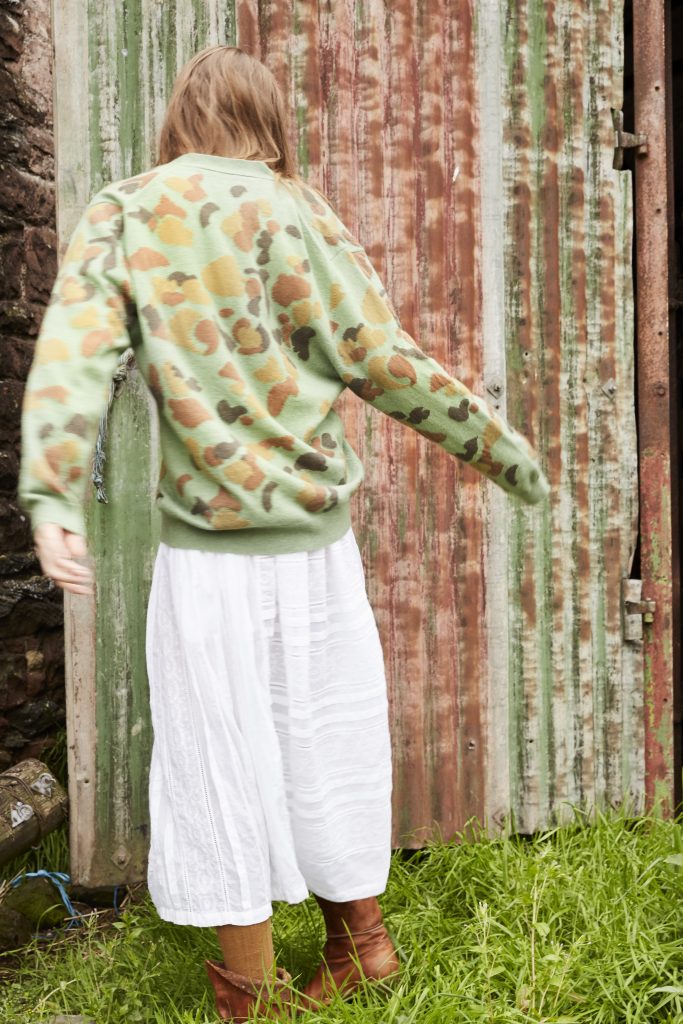
Hokkaido Cardigan, Queene and Belle A/W2018
“Today, production is done on computerised machines which can do pretty much anything that the old machines could do but more efficiently. The stitch of the garments produced is a bit looser, which means the cashmere comes up softer in the initial milling. This is preferred practise now as consumers want to feel the softness instantly. The finishing side of the process is still very much the same as it always was with mainly women doing all of the body linking, collar linking and hand sewing functions.
These are just the general changes in the industry but there are a few mills and specialists still producing garments in the old way, so things have moved on with technological advances but the old ways have not been lost completely!”
How has Digital technologies affected your brand?
“It has had a positive affect for the brand, especially via Instagram. Digital technologies have helped introduce Queene and Belle to individuals who would never have known about us perhaps as there were no stockists near them.”
Who is the Queene and Belle client? What markets respond strongest to your vision? Has this client changed over time or remained the same?
“The Queene and Belle woman is emotionally drawn to our designs; she is an individual who loves unique things, high quality, sustainability, and the story.
Japan and UK are our strongest markets, they love our look.
Our clients have stayed loyal and evolved with us and introduced new ones through word of mouth.”
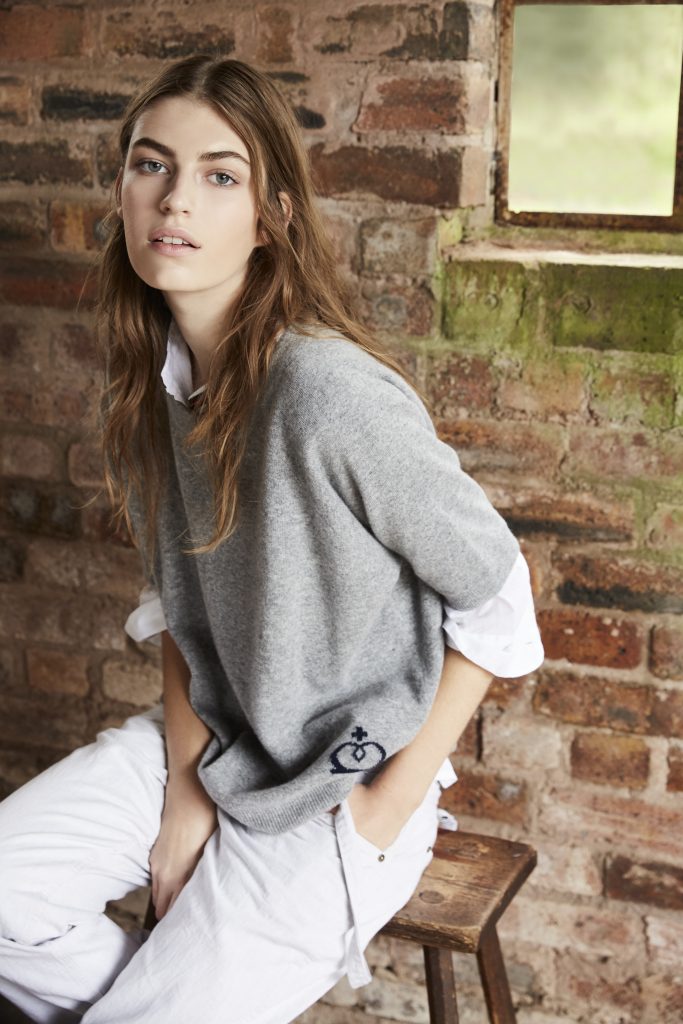
Regal Sweater, Queene and Belle
If you could fix one thing in the fashion industry, what would it be?
“I would like companies to return to producing one collection per season, as there is just too much product now. We really need to stop overproducing at every level of the market.”
What do you wish people would stop doing to their knitwear?
“Abusing it by not treating it with the care it deserves! It’s not leather, it’s a very delicate fabric which needs lots of love and respect! We actually offer a re-dressing service to help to give past Queene and Belle purchases a new lease of life. The service sees the garment returned to its artisan makers where it is washed, de-pilled and professionally pressed.”
Tell us about your collection of Edwardian vintage. What draws you to that era of costume history?
“Primarily white cotton, I adore white cotton as it just lifts everything and in that era it was so fine with lots of lace and embroidery. So feminine and timeless, the look compliments our cashmere perfectly.”
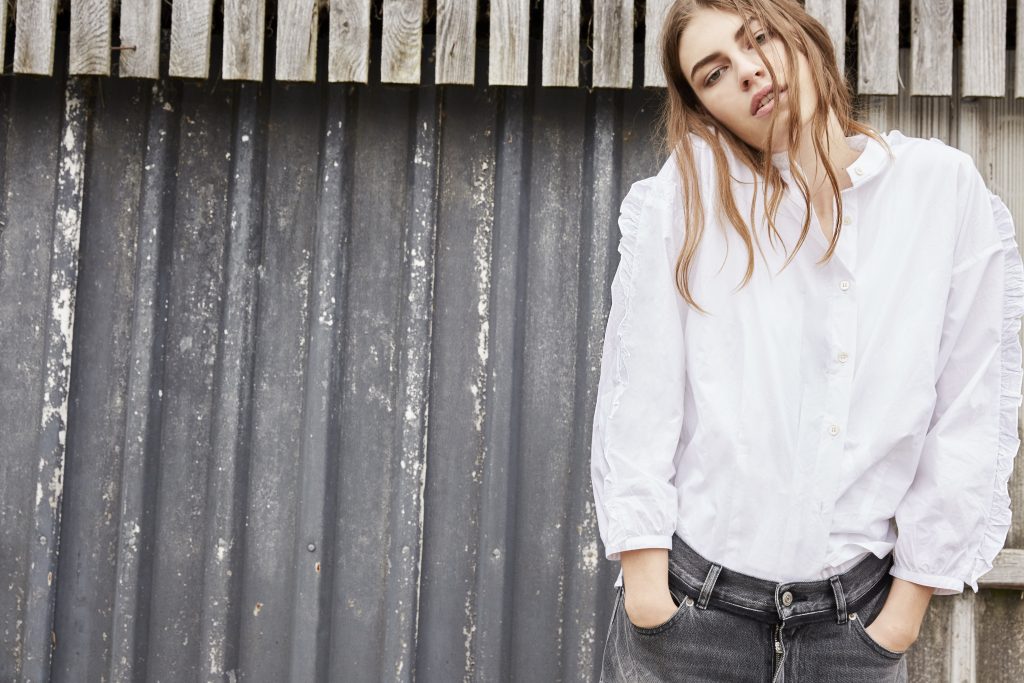
Carrie Shirt, Queene and Belle A/W2018
Where do you see your brand in the future?
“I would love it to continue as it is selling to lovely stores who appreciate the love, thought and care we put in to each of our designs.”
If you were not a fashion designer what would you be?
“In the costume department for films/TV”
Where can we follow you? Where can we get our Queene and Belle fix?
You can follow us on Instagram: @queeneandbelle
The collection is also available to buy at www.matchesfashion.com
To treat your cashmere right and for useful sweater care tips visit Queene and Belle’s site at:
https://queeneandbelle.com/cashmere-care/

